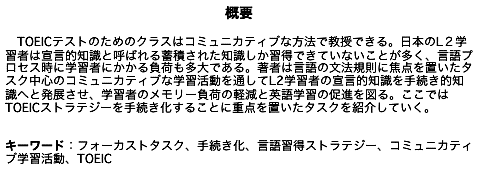|
Abstract
This paper shows how the TOEIC® can be taught communicatively. Learners begin a second language (L2) from a set of rules on linguistic forms,
declarative knowledge. Performing from this knowledge burdens processing capacity, but learners can progress to the procedural knowledge stage
by practicing communicative activities through focused tasks based on linguistic forms, and receiving extensive feedback. This lightens the
processing load. The author points how practicing communicative activities through focused tasks based on cognitive strategy use assists
proceduralization of skills that are beneficial for TOEIC test takers. This paper concludes by mentioning some focused tasks to proceduralize
TOEIC strategies.
Keywords: focused tasks, proceduralization, language learning strategies, communicative activities, TOEIC®

|


